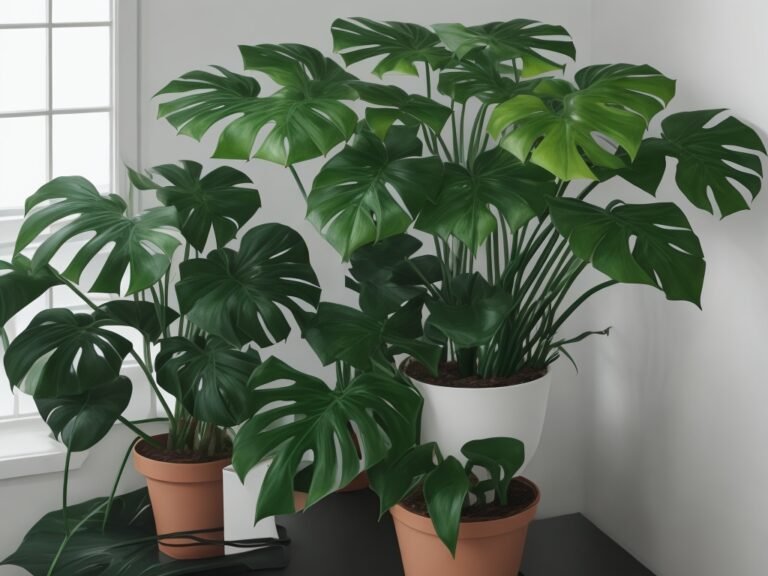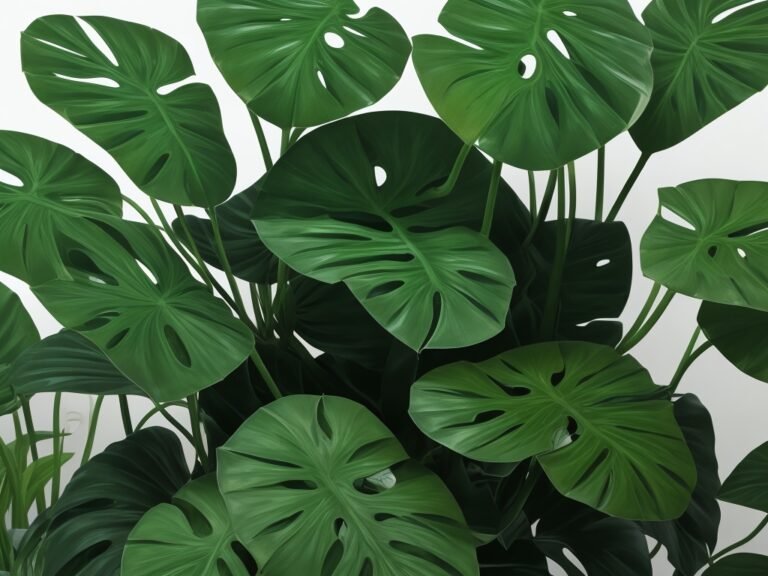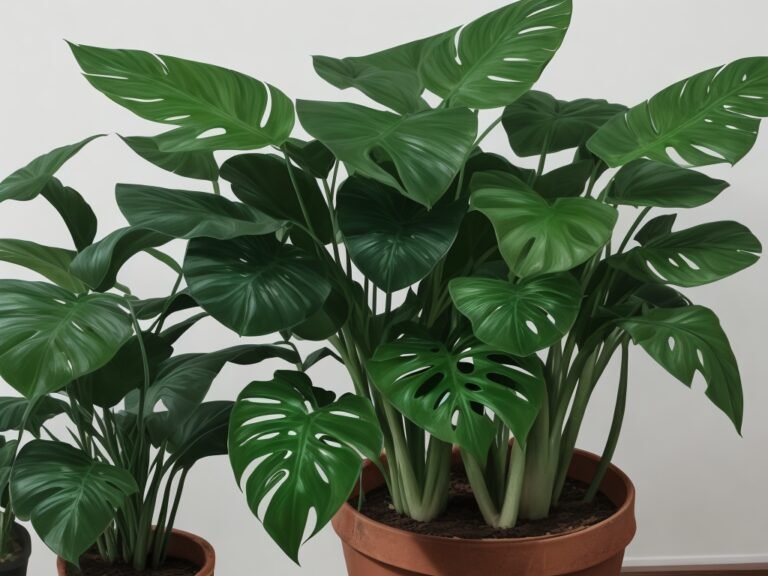How To Identify Different Types Of Monstera Plants?
Key Takeaways:
- Monstera plants have distinct leaves with unique patterns, including fenestrations (holes) and variegation (color variations).
- Different types of Monstera plants can be distinguished by their leaf shape, size, color, and patterns.
- Understanding the characteristics of various Monstera species can help you identify and care for these popular houseplants accurately.
- Key features to look for when identifying Monstera plants include split leaves, perforations, leaf color variations, and overall growth habit.
Do you have a Monstera plant but can’t quite figure out which type it is?
Well, I’m here to help you solve that mystery! In this article, we’ll delve into the world of Monstera plants and learn how to identify the different types.
From the popular Monstera Deliciosa to the elusive Monstera Obliqua, we’ll explore their unique characteristics and descriptions.
Plus, we’ll answer some frequently asked questions, like how to differentiate between Monstera Deliciosa and Monstera Adansonii.
So, get ready to become a Monstera expert and impress your fellow plant enthusiasts with your vast knowledge!
| Monstera Type | Leaf Shape | Leaf Size | Leaf Texture |
|---|---|---|---|
| Monstera Deliciosa | Heart-shaped | Large | Smooth |
| Monstera Adansonii | Swiss cheese-shaped | Small | Holes and perforations |
| Monstera Obliqua | Delicate and narrow-shaped | Small | Thin and almost transparent |
Identifying Monstera Deliciosa
Monstera Deliciosa is a popular tropical plant known for its large, heart-shaped leaves with distinctive fenestrations or holes.
It is easily recognizable by its lush green foliage and vining habit.
Description of Monstera Deliciosa
Monstera Deliciosa, also known as Swiss cheese plant, is a popular and iconic houseplant with large, glossy, and heart-shaped leaves.
The leaves have distinct splits and holes, resembling a piece of Swiss cheese, hence the name.
It is a vine-like plant that can climb or trail, making it versatile for different spaces.
The plant can grow quite large, reaching heights of several feet, and requires bright, indirect sunlight and well-draining soil to thrive.
Its unique foliage and easy care requirements make it a favorite among plant enthusiasts.
Unique characteristics of Monstera Deliciosa
Monstera Deliciosa, also known as the Swiss Cheese Plant, has some unique characteristics that set it apart. Its large, glossy leaves are famous for their distinctive perforations, giving them a unique and eye-catching appearance.
These holes are believed to help the plant withstand strong winds in its natural habitat.
Another interesting feature is the plant’s ability to climb and attach itself to structures using its aerial roots. Additionally, Monstera Deliciosa produces edible fruit, which tastes like a mix of pineapple and banana when fully ripe.

Identifying Monstera Adansonii
Monstera Adansonii has unique characteristics that distinguish it from other Monstera plants.
Description of Monstera Adansonii
Monstera Adansonii, also known as Swiss Cheese Vine or Monkey Mask, is a popular houseplant with unique foliage.
It features heart-shaped leaves that have multiple oval-shaped holes, giving it a distinctive and attractive look.
The leaves are usually green, but some varieties may have variegated patterns with white or yellow markings.
This plant is a vining species that can grow both indoors and outdoors, and it is known for its fast growth rate.
Overall, Monstera Adansonii is a visually stunning plant that adds a touch of tropical beauty to any space.
Unique characteristics of Monstera Adansonii
Monstera Adansonii, also known as the Swiss Cheese Plant, is characterized by its unique fenestrated leaves. These leaves have holes or splits that give them a distinctive appearance.
The holes develop as the plant grows and mature.
Another unique feature of Monstera Adansonii is its trailing vines, which make it a popular choice for hanging baskets or for training on a support.
Identifying Monstera Obliqua
Monstera Obliqua can be identified by its small, delicate leaves with numerous holes and narrow slits that cover the entire leaf surface. It is also known for its vining growth habit, which makes it distinct from other Monstera varieties.
Description of Monstera Obliqua
Monstera Obliqua, also known as the “Swiss Cheese Vine,” is a unique and delicate plant.
Its leaves are full of neatly spaced holes, giving it a distinct and eye-catching appearance.
The leaves are also smaller compared to other Monstera varieties, making it a popular choice for hanging baskets or terrariums.
Its growth rate is moderately fast, making it an exciting plant to watch as it develops new leaves.
Just be sure to provide it with plenty of indirect light and keep the humidity levels up to keep it thriving.
Unique characteristics of Monstera Obliqua
Monstera Obliqua, also known as the Swiss Cheese Vine, has unique characteristics that set it apart from other Monstera plants.
Its leaves are delicate and have large, oval-shaped holes and elongated slits, creating a beautiful and intricate pattern.
It is a vining plant that typically grows smaller in size compared to other Monstera varieties.
The leaves of Monstera Obliqua are also thinner and more flexible, giving them a delicate and airy appearance.
Additionally, Monstera Obliqua is known for its fast growth rate and ability to trail or climb up surfaces, making it a popular choice for hanging or trellis displays.

Identifying Monstera Siltepecana
beautiful tropical plant be identified by its small heart-shaped leaves with distinct silver markings and its vining growth habit.
Description of Monstera Siltepecana
Monstera Siltepecana, also known as the Silver Monstera, is a beautiful tropical plant with heart-shaped leaves that are dark green with silver variegation.
It is a vining plant that can grow up to 3 feet in height.
The leaves have distinct perforations, similar to other Monstera varieties, but the Silver Monstera’s leaves are smaller and more elongated.
The plant is relatively easy to care for and can thrive in bright indirect light and well-draining soil.
Its unique silver variegation adds a touch of elegance to any indoor or outdoor space.
Unique characteristics of Monstera Siltepecana
Monstera Siltepecana has unique characteristics that set it apart from other Monstera plants.
It has elongated heart-shaped leaves with deep green color and silver veins.
The leaves are also slightly serrated, giving them a distinctive look.
Another unique feature is the pattern of leaf variegation, which varies from plant to plant.
This Monstera is known for its trailing growth habit, making it perfect for hanging baskets or climbing up a moss pole.
It is also a relatively compact plant, making it suitable for smaller spaces.
Identifying Monstera Standleyana
Monstera Standleyana is easily identified by its unique pattern of variegated leaves.
Description of Monstera Standleyana
Monstera Standleyana, also known as the “Five Holes Plant,” is a unique species of Monstera known for its beautiful foliage.
Its leaves are heart-shaped with multiple perforations, creating a unique pattern.
The leaves have a bright green color with silver-white veins.
This plant is a vine that grows quickly and can climb with proper support.
It is an excellent choice for indoor or outdoor spaces, adding a touch of tropical beauty to any environment.
Unique characteristics of Monstera Standleyana
Monstera Standleyana, also known as “Five Holes Plant,” has unique characteristics that set it apart from other Monstera varieties.
Its leaves feature distinct five-lobed shapes with elongated holes, giving it an intricate and eye-catching appearance.
The leaves also have beautiful variegation, with vibrant shades of dark green and silver along the veins.
Additionally, Monstera Standleyana has a trailing growth habit, making it a popular choice for hanging baskets or climbing up trellises.
Overall, its unique leaf shape and variegation make it a standout plant in any collection.
Identifying other types of Monstera plants
Let’s explore how to identify different types of Monstera plants and learn about their unique characteristics.
Description of other Monstera plant varieties
Monstera plants come in various varieties, each with its own unique characteristics.
Some other popular types include Monstera Adansonii, with its narrow and elongated leaves; Monstera Obliqua, known for its delicate and holey leaves; Monstera Siltepecana, which has small, silver-veined leaves; and Monstera Standleyana, with its stunning variegated leaves.
These varieties add diversity and beauty to any plant collection.
Unique characteristics of other Monstera plant varieties
Other Monstera plant varieties each have their unique characteristics that set them apart. Here are a few examples:
- Monstera Adansonii: Known as the “Swiss Cheese Vine,” this plant has smaller, heart-shaped leaves with distinctive holes and cuts, giving it a lacy appearance.
- Monstera Obliqua: Also called the “Swiss Cheese Plant,” it has leaves that are much more perforated than Monstera Deliciosa, with numerous small holes all over the foliage.
- Monstera Siltepecana: This plant has elongated, lance-shaped leaves that are entirely covered in silver markings, resembling frost or delicate veins.
- Monstera Standleyana: Named the “Five-Hole Plant,” it features leaves with unique elliptical cutouts, creating five distinct lobes.
Each of these Monstera varieties has its own charm and allure, showcasing nature’s creativity through their striking leaf patterns and shapes.

Frequently Asked Questions about identifying Monstera plants
How do I differentiate between Monstera Deliciosa and Monstera Adansonii?
Monstera Deliciosa has large, glossy, and heart-shaped leaves with distinct splits or holes, while Monstera Adansonii has smaller, more delicate leaves with multiple holes along the edges. Additionally, Monstera Deliciosa leaves are usually broader and have a darker green color compared to the lighter green leaves of Monstera Adansonii.

Can Monstera Obliqua be grown indoors?
Yes, Monstera Obliqua can be grown indoors.
It prefers bright, indirect light and high humidity.
Place it near a window with filtered sunlight, and mist the leaves regularly.
Use a well-draining potting mix and water when the top inch of soil is dry.
Ensure proper air circulation to prevent any fungal diseases.
How can I identify a rare Monstera Siltepecana?
To identify a rare Monstera Siltepecana, look for these unique characteristics: dark green leaves with silver markings, deeply-lobed foliage, and a thick, succulent-like texture.
The leaves also have small holes, similar to Monstera Deliciosa, but the holes in Siltepecana leaves tend to be more elongated and thinner.
Additionally, Siltepecana has a trailing growth habit and its stems are often reddish in color.
Are there any specific care requirements for Monstera Standleyana?
Monstera Standleyana, also known as the “Five Holes Plant,” is a relatively easy-care plant.
It prefers bright indirect light but can tolerate medium light conditions.
Keep the soil slightly moist and water when the top inch of soil feels dry.
Mist the leaves occasionally to provide humidity.
Use well-draining soil and fertilize monthly during the growing season.
Regular pruning helps maintain its bushy appearance.
Overall, it’s a resilient plant that will thrive with proper care.
What are some lesser-known types of Monstera plants?
Sure thing! When it comes to lesser-known types of Monstera plants, there are a few varieties that might not be as popular as the Monstera Deliciosa or Monstera Adansonii.
Here are a couple of examples:
- Monstera Obliqua: This plant is known for its unique leaf structure, with large oval-shaped holes and fenestrations. It’s often referred to as the “Swiss Cheese Plant” due to its hole-ridden leaves.
- Monstera Siltepecana: This Monstera variety has elongated, heart-shaped leaves with distinct silver markings. They add a touch of elegance to any space and are relatively low maintenance.
- Monstera Standleyana: With its elongated, lance-shaped leaves and silver variegated patterns, the Monstera Standleyana is a beautiful and eye-catching plant. It’s commonly called the “Five Holes Plant” due to the interesting fenestrations on its leaves.
These are just a few examples of lesser-known Monstera plant varieties.
Each one has its own unique characteristics that make them a delightful addition to any plant lover’s collection.
Final Verdict
Identifying different types of Monstera plants requires careful observation and knowledge of their unique characteristics. Monstera Deliciosa stands out with its large, perforated leaves, while Monstera Adansonii features smaller, heart-shaped leaves with distinctive fenestrations.
Monstera Obliqua is rare and delicate, with thin leaves and intricate perforations.
Monstera Siltepecana sports velvety leaves with silver veins, and Monstera Standleyana boasts elongated leaves with distinct white markings. Additionally, there are other varieties of Monstera plants with their own distinguishing features.
By understanding these key differences, plant enthusiasts can confidently identify and care for their Monstera plants.





